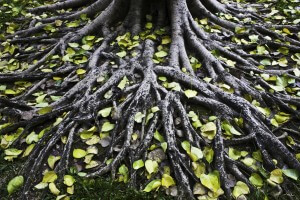Healthy roots make for healthy trees. They absorb water and minerals, food and water storage, and anchorage. Fostering root growth will build strong, hearty trees. Roots are predominantly located in the top 6 to 24 inches of the soil and occasionally can grow deeper 3 to 7 feet if soil conditions allow. They tend to grow about 2 to 4 times the diameter of the crown.
There are many ways to injure tree roots and stress trees. Some injuries are unintentional and cannot be avoided. However, most root damage can be avoided with some care.
One of the biggest killers of urban trees is use of heavy clay subsoils instead of topsoil and soil compaction. Heavy clays and soil compaction restricts water and oxygen uptake by roots.
Balance is the key to keeping roots their best, too much or too little of anything can be detrimental to your trees.
Changes in soil depth around trees can also cause injury to root systems. The addition of only 4 to 6 inches of soil over an existing root system drastically reduces the amount of oxygen and water available to the roots. Conversely, removing the soil around an existing tree can expose and injure roots, change the soil conditions where roots grow, and reduce water availability.
Overwatering causes the soil air spaces to fill with water and restrict oxygen. Underwatering does not provide sufficient water for proper root development. Overfertilization can injure or kill the roots, but underfertilization results in a lack of the minerals essential to maintain a healthy tree. Competition for water and minerals between tree roots, bushes, grass and flowers can also stress trees. Trees can be stressed from root damage by routine soil preparation in the tree’s root zone for flower planting.
When there are problems with your root systems it will show throughout the entire tree. Symptoms of root disease include small, yellow, chlorotic foliage reduced growth; scorch; tufted leaves at the end of branches; and branch dieback. Mushrooms or conks at the base of the tree, as well as white fungal growth under the bark, may also be a sign of root disease. Symptoms of root problems from construction damage or other detrimental activities may appear one to several years after the damage occurred.
If you suspect your tree may be suffering from root problems contact the certified arborists at Organically Green, (631) 467-7999.

